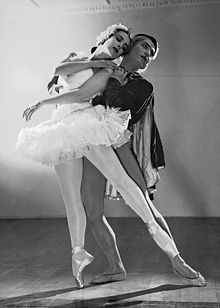Les biches
Les biches is a ballet choreographed by Bronislava Nijinska to music by Francis Poulenc, premiered by the Ballets Russes on 6 January 1924. Some consider this piece a milestone in ballet history. The composer, who was at the time relatively unknown, was asked by Serge Diaghilev to write a piece based on Glazunov's Les Sylphides, written seventeen years earlier. Poulenc, however, chose to base his work on the paintings of Watteau that depicted Louis XV and various women in his "Parc aux biches." The word biche is usually translated as "doe," an adult female deer. "Does" was used as a slang for coquettish women. Poulenc described his work as a "contemporary drawing room party suffused with an atmosphere of wantonness, which you sense if you are corrupted, but of which an innocent-minded girl would not be conscious."
Diaghilev recognized the great potential of the ballet and produced it for the 1924 Ballet Russes season, bringing Poulenc into the forefront of French music. Les biches was well received by critics and liked by the fashionable audience, with Henri Malherbe of Time calling it "surprisingly intimate." Jean Cocteau upon approving the work's unplanned grandeur wrote: "The beauty, the melancholy of Les biches results from a lack of artifice." Poulenc continually revised the music up through the 1940s, eventually reducing it to an orchestral suite in five movements.
The ballet, written in a light and frothy style, is in turns reminiscent of Mozart, Scarlatti, Franck, Tchaikovsky, and Stravinsky, mirroring the style of Saint-Saëns's private composition The Carnival of the Animals. Les biches uses a hidden chorus in addition to the pit orchestra, a device found before in Ravel's Daphnis et Chloé. The set and costumes were designed by Marie Laurencin, giving a sense of upper-class fashion.
The score was reset for New York City Ballet's Jazz Concert by Francisco Moncion, the other three dances being Todd Bolender's Creation of the World, John Taras' Ebony Concerto and George Balanchine's Ragtime (I). The NY City Ballet premiere took place on 7 December 1960 at the City Center of Music and Drama.
Story and characters
The ballet relates the happenings of a group of people in the south of France, interacting at a fashionable house party in the 1920s. The sexual identity of its characters is intended to be ambiguous.
Among the characters introduced are:
- The Hostess — in full party attire with pearl necklace and a long cigarette holder (originally danced by Nijinska herself);
- Three male athletes;
- La Garçonne — a girl dressed in blue velvet with white gloves and tights, who dances a pas de deux with one of the athletes;
- Two young girls whose interactions may lead one to believe they are lesbians.
Originally, the dances were identified by the musical titles: "Rondeau," "Chanson dansee," "Adagietto," "Jeu," "Rag Mazurka," "Andantino," "Chanson dansee," and "Finale." The character of La Garçonne (The Bachelor Girl), was modelled after the character in Victor Margueritte's novel of the same name.
Casts
Ballet Russes de Diaghilev (1924) Nijinska, Nemchinova, Tchernicheva, Sokolova, Vilzak, Woizikowski, Zvereff.
Markova-Dolin Ballet (1937)
The Marquis de Cuevas Grand Ballet de Monte Carlo (1949)
New York City Ballet (1960)
|
|
The Royal Ballet (1964)
Ballet West, 2009 Fall for Dance Festival
|
Oakland Ballet (1982)
Dance Theater of Harlem
Companhia de Dança de Lisboa
References and external links
- The Independent: Obituary: Georgina Parkinson, Ballerina Best Known for her Performance as La Garconne in Nijinska's 'Les Biches'"
- "Nijinska's 'Les Biches' by the Dance Theatre of Harlem", New York Times, 29 January 1983
- Judith Lynne Hanna, Dance, Sex, and Gender: Signs of Identity, Dominance, Defiance, and Desire, University of Chicago Press, 1988
- Au, Susan. Ballet and Modern Dance. 2nd ed. London: Thames & Hudson. 2002. Print.
| ||||||||||||||||||||||||||||||||||
| ||||||||||||||||||||||||||||||||||||
